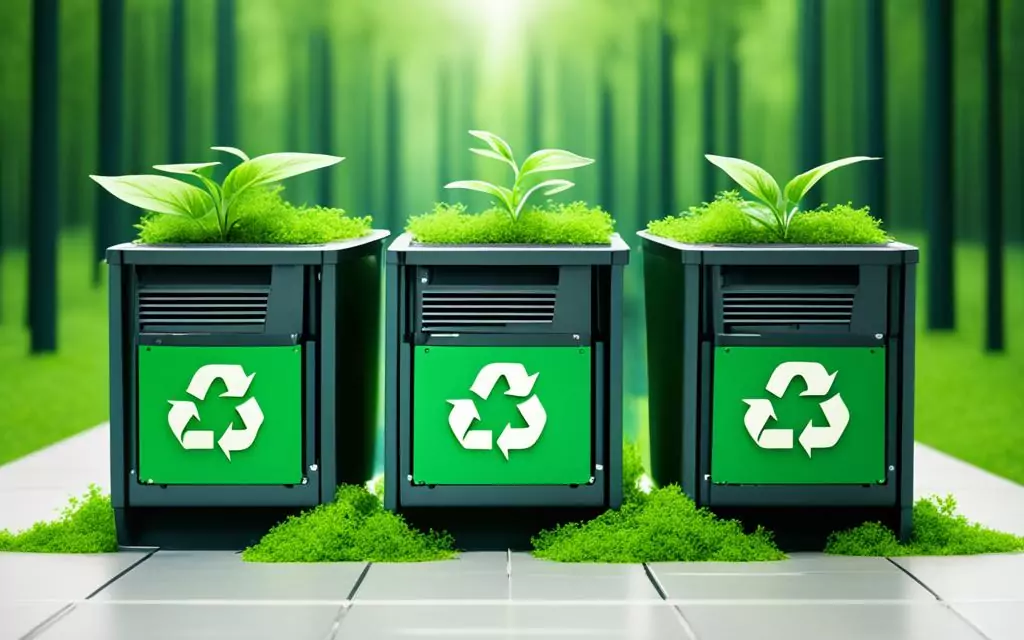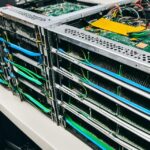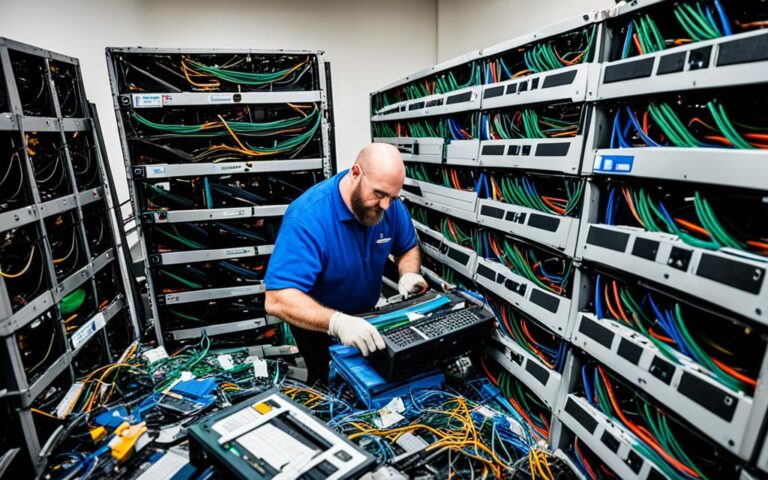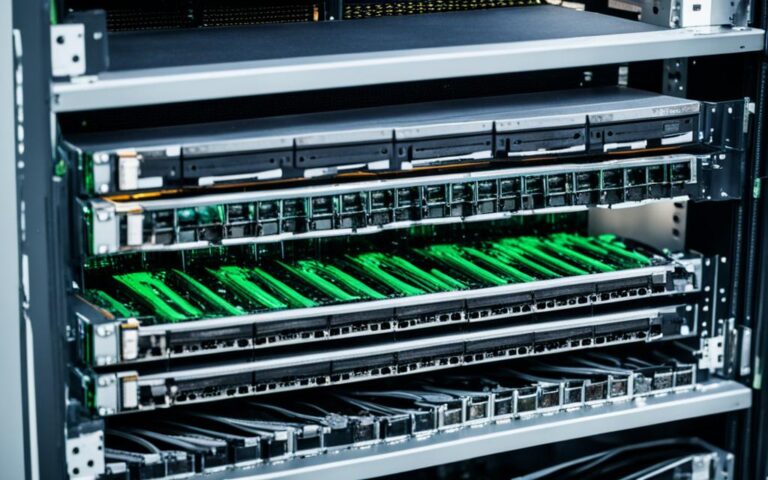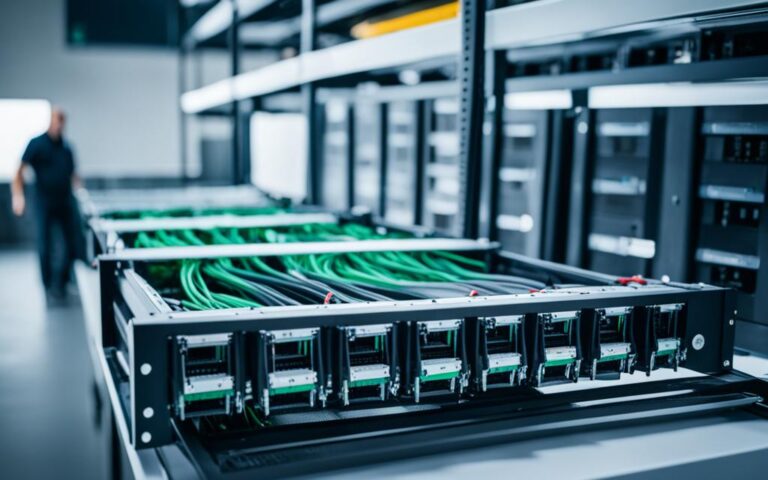How Server Recycling Can Support Green Computing Practices
Server recycling is more than just disposing of old hardware. It is a vital practice that can make a significant impact on our planet’s environmental sustainability. In the digital age, data centres are the backbone of our technological infrastructure. However, they consume vast amounts of energy, generate electronic waste, and strain precious water resources.
By embracing server recycling, we can address these environmental challenges and move towards a greener future for the IT industry. Server recycling involves responsibly disposing of old servers and reusing their components to minimize electronic waste. This reduces the need for raw materials and energy-intensive manufacturing processes required to produce new servers.
Not only does server recycling contribute to a circular economy, but it also promotes energy efficiency. Recycling old servers reduces the demand for power-hungry hardware and encourages the adoption of more energy-efficient technologies. This, in turn, reduces the carbon footprint of data centres and lowers their overall environmental impact.
Furthermore, server recycling supports the concept of green computing practices. Green computing focuses on implementing sustainable strategies in data centres to minimize resource consumption and optimize operational efficiency. By recycling servers, we can conserve energy, reduce e-waste, and promote responsible resource management.
Join the movement towards a greener future. Embrace server recycling and support green computing practices. Together, we can make a positive impact on the environment and create a more sustainable IT industry.
The Benefits of Green Computing Practices
Green computing practices, also known as sustainable IT or eco-friendly computing, are essential for minimizing the environmental impact of data centres. By adopting these practices, we can optimize energy efficiency, reduce resource consumption, and lower operational costs. Green computing not only benefits the environment but also enhances corporate social responsibility and improves a company’s brand image. By implementing energy-efficient strategies, conserving water, and responsibly managing e-waste, data centres can become more sustainable and contribute to a greener future.
Optimizing energy efficiency is a key aspect of green computing practices. Data centres can achieve this by employing virtualization techniques, using energy-efficient hardware, and implementing smart power management systems. By reducing energy consumption, data centres not only lower their carbon footprint but also save on operational costs.
Conserving water is another important consideration. Data centres consume significant amounts of water for cooling purposes. By implementing innovative cooling solutions such as liquid cooling technology and water recycling systems, data centres can minimize water consumption and contribute to water conservation efforts.
“Green computing practices are not only environmentally responsible but also financially advantageous. By adopting energy-efficient strategies, data centres can significantly reduce their resource consumption, lower their operational costs, and improve their bottom line.” – Steve Smith, IT Manager at GreenTech Solutions
Responsibly managing e-waste is another crucial aspect of green computing. Data centres generate a substantial amount of electronic waste, including outdated servers and IT equipment. By implementing proper disposal methods, recycling initiatives, and extending the lifespan of hardware through upgrades and maintenance, data centres can minimize e-waste and contribute to a more sustainable IT industry.
Green computing practices also have a positive impact on corporate social responsibility (CSR). By adopting environmentally responsible practices, companies demonstrate their commitment to sustainability and the well-being of the planet. This not only enhances a company’s brand image but also attracts environmentally conscious customers and stakeholders.
To further emphasize the benefits of green computing practices, let’s take a look at a table comparing the resource consumption and environmental impact of traditional data centres versus those implementing green computing practices:
| Resource Consumption | Environmental Impact | |
|---|---|---|
| Traditional Data Centres | High | Significant carbon footprint, water wastage, and e-waste generation |
| Green Computing Data Centres | Optimized through energy-efficient practices | Lower carbon footprint, water conservation, and responsible e-waste management |
The table clearly illustrates the advantages of green computing practices in terms of resource consumption and environmental impact. By adopting green computing practices, data centres can significantly reduce their resource consumption, lower their carbon footprint, and contribute to a more sustainable IT industry.
Implementing green computing practices is not just a responsibility; it is an opportunity to create a greener future. By optimizing energy efficiency, conserving water, responsibly managing e-waste, and embracing sustainable technologies, data centres can play a crucial role in environmental preservation and meet the growing demand for environmentally friendly IT solutions.
Key Strategies for Green Computing
Implementing energy efficiency measures is a crucial aspect of green computing. By optimizing energy consumption in data centres, we can significantly reduce their environmental impact and contribute to a more sustainable future.
1. Virtualization
Virtualization is a key practice in green computing that involves running multiple virtual servers on a single physical server. By consolidating workloads, virtualization optimizes server utilization, reducing energy consumption and the need for additional hardware. This not only lowers costs but also minimizes the carbon footprint of data centres.
2. Efficient Cooling Systems
Inefficient cooling systems can account for a significant portion of data centre energy consumption. By implementing innovative cooling solutions such as liquid cooling technology, data centres can efficiently dissipate heat and reduce the need for excessive air conditioning. This results in lower energy consumption and improved energy efficiency.
3. Smart Power Management
Smart power management techniques, such as power capping and dynamic voltage scaling, enable data centres to optimize energy usage based on workload demands. By dynamically adjusting power consumption according to server utilization, data centres can achieve significant energy savings without compromising performance.
4. Water Conservation
Water conservation is another important strategy in green computing. Data centres can minimize water usage by adopting innovative cooling solutions that utilize water recycling systems. By recycling water and implementing efficient cooling methods, data centres can effectively reduce their water footprint and contribute to responsible water resource management.
5. Responsible E-Waste Management
Responsible e-waste management is crucial for a sustainable IT industry. By properly disposing of electronic waste, recycling old hardware, and extending the lifespan of equipment through upgrades and maintenance, data centres can minimize their environmental impact. Responsible e-waste management ensures that valuable resources are conserved and harmful materials are disposed of safely.
By adopting these key strategies for green computing, data centres can achieve greater energy efficiency, conserve water resources, and responsibly manage e-waste. Embracing sustainable practices in the IT industry is essential for creating a greener future and ensuring the long-term sustainability of our digital infrastructure.
The Role of Renewable Energy in Green Computing
Embracing renewable energy sources is a progressive step towards green computing. By utilizing solar power, wind power, and hydroelectric power, data centres can reduce their reliance on traditional energy sources and significantly lower their carbon footprint. The adoption of renewable energy not only promotes environmental sustainability but also offers long-term cost savings.
“Renewable energy is the key to a sustainable future.”
Many regions offer incentives and subsidies to encourage the transition to renewable energy. By embracing these clean energy sources, data centres can make a positive impact on the environment and support the global shift towards a greener future.
Benefits of Solar Power in Green Computing
Solar power is one of the most popular renewable energy sources used in green computing. By harnessing energy from the sun, data centres can generate electricity while reducing their reliance on fossil fuels. Solar panels can be installed on the roofs or grounds of data centres and provide a clean and renewable source of power.
- Solar power reduces greenhouse gas emissions, contributing to a cleaner and healthier environment.
- It reduces electricity costs over time, leading to significant savings for data centres.
- Solar panels can be integrated with smart power management systems to optimize energy usage and reduce wastage.
Benefits of Wind Power in Green Computing
Wind power is another valuable renewable energy source in the realm of green computing. By harnessing the power of wind through wind turbines, data centres can generate electricity without depleting natural resources or emitting harmful pollutants.
- Wind power is a clean and abundant energy source, contributing to a greener and more sustainable future.
- It reduces the reliance on conventional energy sources, such as coal or natural gas, which contribute to air pollution and climate change.
- Wind turbines can be installed in various locations, both onshore and offshore, making it a versatile option for data centres.
By embracing renewable energy sources like solar power and wind power, data centres can not only reduce their environmental impact but also set an example for other industries. The shift towards clean and sustainable energy is a crucial step in building a greener future.
Conclusion
Green computing practices are essential in our digital age to reduce the environmental impact of data centres. By optimizing energy efficiency, conserving water, responsibly managing e-waste, and embracing renewable energy sources, data centres can become more environmentally friendly and contribute to sustainability.
It is crucial for governments and businesses to collaborate and establish a regulatory framework that encourages and rewards sustainable practices in data centres. By implementing policies that promote green computing, we can create a brighter future for our planet and future generations.
While the journey towards greener data centres may have its challenges, it is a path worth taking. By adopting green computing practices, we can minimize the carbon footprint and promote a healthier environment. Let’s work together to make our digital infrastructure more sustainable, ensuring the well-being of our planet and future generations.
For more information on server recycling and how it supports green computing practices, visit IT-Recycle UK.
FAQ
What is server recycling and how does it support green computing practices?
Server recycling is the process of properly disposing and recycling servers to reduce electronic waste and promote environmental sustainability. By recycling servers, we can conserve energy and contribute to a greener future for the IT industry.
Why are green computing practices important?
Green computing practices, also known as sustainable IT or eco-friendly computing, are essential for minimizing the environmental impact of data centres. By adopting these practices, we can optimize energy efficiency, reduce resource consumption, and lower operational costs.
How can data centres achieve greater sustainability through green computing?
Data centres can achieve greater sustainability through green computing by implementing energy efficiency measures, conserving water, and responsibly managing e-waste. Practices such as virtualization, efficient cooling systems, and smart power management can significantly reduce energy consumption. Innovative cooling solutions and water recycling systems can help minimize water usage. Responsible e-waste management involves proper disposal, recycling, and extending the lifespan of hardware through upgrades and maintenance.
What is the role of renewable energy in green computing?
Embracing renewable energy sources, such as solar power, wind power, and hydroelectric power, is a progressive step towards green computing. By utilizing these clean energy sources, data centres can reduce their reliance on traditional energy sources and significantly lower their carbon footprint, while also offering long-term cost savings.
How can governments and businesses promote sustainable practices in data centres?
It is imperative for governments and businesses to work together to create a regulatory framework that encourages and rewards sustainable practices in data centres. This can be done by offering incentives and subsidies for the adoption of energy-efficient strategies, water conservation measures, responsible e-waste management, and the use of renewable energy sources.

